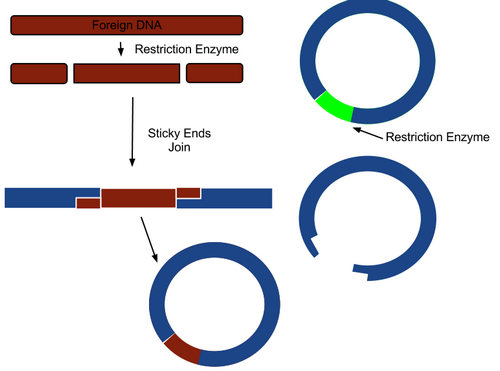 One
of the important uses of recombinant DNA technology is the cloning of (i)
random DNA or cDNA segments, often used as probes or (ii) specific genes, which
may be either isolated from the genome or synthesized organochemically or in
the form of cDNA from mRNA. This cloning of DNA is possible only with the help
of another DNA molecule, which is capable of replicating in a host. This other
DNA molecule is often used in the form of a vector, which could be a plasmid, a bacteriophage, a derived cosmid or phagemid, a transposon or even a virus.
Techniques should also be available, which will allow selection of chimeric
genomes obtained after insertion of foreign DNA from a mixture of chimeric and
the original vector. Another critical desired feature of any cloning vector is
that it should possess a site at which foreign DNA can be inserted without
disrupting any essential function. Therefore, in each case an enzyme will also
have to be selected which will cause a single break. Sometimes vectors ate
modified by inserting a DNA segment to create unique site(s) for one or more
enzymes to facilitate its use in gene cloning. This DNA with restriction sites
for several enzymes is sometimes called a polylinker.
One
of the important uses of recombinant DNA technology is the cloning of (i)
random DNA or cDNA segments, often used as probes or (ii) specific genes, which
may be either isolated from the genome or synthesized organochemically or in
the form of cDNA from mRNA. This cloning of DNA is possible only with the help
of another DNA molecule, which is capable of replicating in a host. This other
DNA molecule is often used in the form of a vector, which could be a plasmid, a bacteriophage, a derived cosmid or phagemid, a transposon or even a virus.
Techniques should also be available, which will allow selection of chimeric
genomes obtained after insertion of foreign DNA from a mixture of chimeric and
the original vector. Another critical desired feature of any cloning vector is
that it should possess a site at which foreign DNA can be inserted without
disrupting any essential function. Therefore, in each case an enzyme will also
have to be selected which will cause a single break. Sometimes vectors ate
modified by inserting a DNA segment to create unique site(s) for one or more
enzymes to facilitate its use in gene cloning. This DNA with restriction sites
for several enzymes is sometimes called a polylinker.
Authored and published by;
Raj Abhisek Panda






